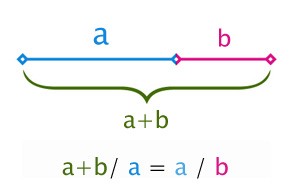In one of our Discovering Mathematics lectures we looked at the relationship between Maths and Art. I was interested to find out more about this link as it was not one that was immediately obvious to me.
There was a particular focus placed on the idea of the Golden Ratio.
The Golden Ratio can be represented as the Greek symbol phi:
but is more commonly known as the ‘special’ number approximately equal to 1.618.
The theory behind the Golden Ratio is that when a line is divided into two parts, the longer section divided by the smaller section is equal to the full line divided by the longer section.
It is said that the Golden Ratio is very aesthetically pleasing, perhaps even beautiful, which may begin to explain the links between the underlying mathematic principles and art. This house emphasises how Maths can extend beyond the classroom and into the wider society as this is an example of the golden ration being used in architecture and design. The pillars and doors are of an equal length and the windows have all been carefully measured to ensure that they are of equal proportion, creating the perfect house.
A coherent knowledge of how Maths can be linked to the wider society as well as other subjects means teachers can enable pupils to develop their skills in mathematics whilst also taking part in interdisciplinary learning as highlighted in the Curriculum for Excellence.



